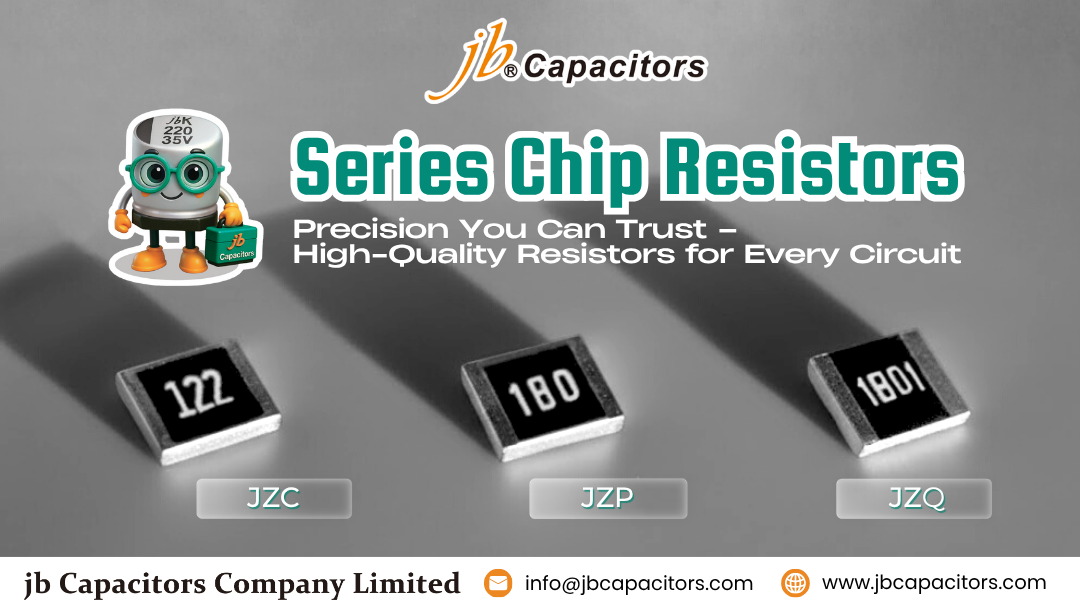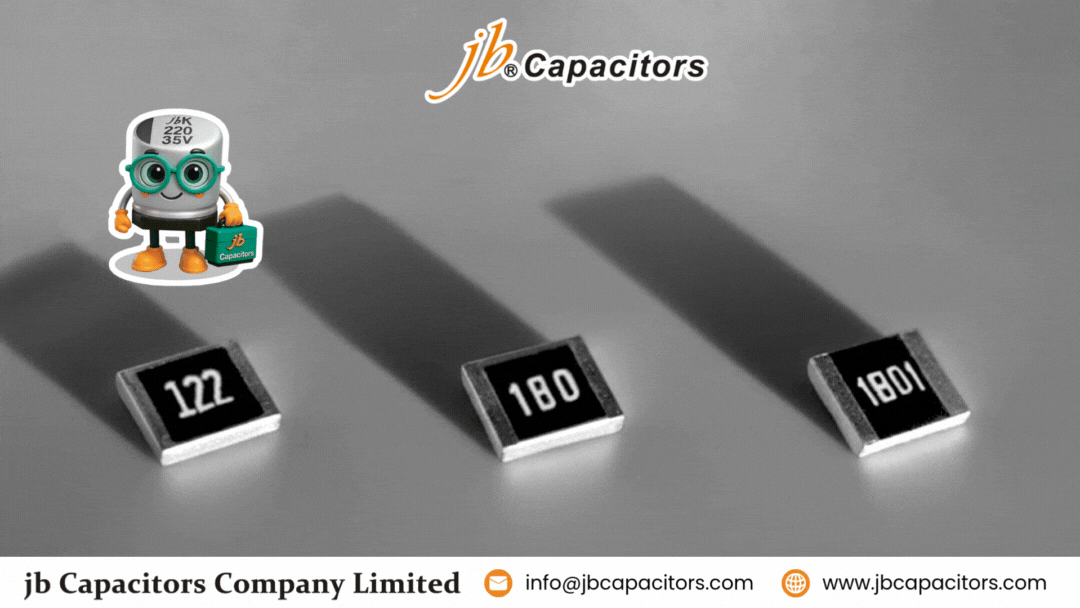MLCC + Thick Film Resistor New Series|High Voltage, RF, Automotive & High Power Solutions

Surface-mount multilayer ceramic capacitors (MLCCs) and thick film chip resistors sit at the core of every stable electronic design. When engineers match them correctly, they control noise, surge behavior, timing accuracy, EMC performance and long-term reliability. However, when the pairing is poor, designs suffer from unstable rails, unexpected ringing, overheating and early field failures.
To help design teams build consistent RC networks across product families, jb capacitors provides a unified thick film chip resistor platform that pairs naturally with jb SMD MLCCs: JZC (general-purpose), JZP (high power) and JZQ (automotive AEC-Q200). In this article, we outline the three series and show how they fit into high voltage, RF, automotive and high power designs.
1. Featured thick film chip resistor series
All three series share a robust thick film construction, nickel barrier with matte tin terminations and SMD formats. Nevertheless, each family targets a different design focus so engineers can choose the most efficient option instead of overspecifying every circuit.



| Series | Primary focus | Typical applications | Recommended MLCC pairing | Qualification level |
|---|---|---|---|---|
| JZC | General-purpose SMD thick film resistor | Logic and control boards, consumer and communication products, bias networks, RC timing and basic filtering. | Standard jb MLCCs for low-voltage decoupling, timing and signal conditioning on 5 V–48 V rails. | Industrial / commercial grade with stable performance over rated temperature and load life. |
| JZQ | Automotive, AEC-Q200, anti-sulfur | ECUs, body control modules, lighting, HVAC, sensor interfaces and power distribution in vehicles. | Automotive-grade jb MLCCs with extended temperature range for 12 V / 24 V and higher-voltage vehicle buses. | AEC-Q200 qualified, anti-sulfur performance for polluted and high-humidity environments. |
| JZP | High power and surge capability | LED drivers, motor drives, industrial power supplies, inrush limiting, pre-charge and discharge networks. | High-voltage or ripple-capable jb MLCCs for snubber, EMI and DC-link support on high-energy nodes. | High power SMD rating with strong pulse and surge performance in compact footprints. |
Together with suitable jb MLCC series (general-purpose, high voltage or RF-grade), these resistors create a coherent platform for decoupling, timing, sensing, snubbing and protection across a wide range of applications. As a result, teams can reuse proven RC blocks instead of redesigning networks for every project.
2. Why MLCC + thick film resistor matching matters
In the real world, MLCCs and thick film resistors do not behave like ideal components. Instead, they show several important second-order effects:
- MLCCs lose capacitance under DC bias, temperature and aging.
- Thick film resistors change resistance with temperature, load, surge and humidity.
Because of this, RC networks can drift out of spec, filters may shift their cutoff frequency, voltage dividers can lose accuracy and surge paths might not absorb energy as expected. When engineers deliberately match the MLCC and resistor series and follow aligned derating and qualification data, they can:
- Predict worst-case behavior instead of relying only on nominal values.
- Pass EMC and safety tests with fewer redesign cycles.
- Guarantee long-term stability in automotive and industrial environments.
3. Key application areas for JZC, JZP and JZQ
3.1 General-purpose logic and control (JZC + standard MLCCs)
The JZC series targets entertainment, appliance, computer and communication products where compact size and stable electrical performance matter, but full automotive qualification is not required. When designers combine JZC with standard jb MLCCs, the pair works well for:
- Pull-up / pull-down networks and bias resistors on microcontroller boards.
- RC timing and simple analog filters in housekeeping circuits.
- General decoupling and signal conditioning around low-voltage rails.
3.2 High voltage and power rails (JZC / JZP + high voltage MLCCs)
On higher-voltage buses and isolation stages, designers often choose high voltage MLCCs for dv/dt control and EMI reduction. In these nodes, JZC or JZP resistors commonly support:
- Discharge and bleed resistors for bulk capacitors.
- Voltage dividers for monitoring and feedback.
- Snubber and inrush-limiting networks around power switches.
Designers usually choose JZP when the resistor must handle more continuous power or repetitive surge energy in a limited footprint. This approach avoids oversized through-hole parts while keeping the layout compact.
3.3 RF and high-frequency nodes (JZC + low-loss MLCCs)
For RF and high-speed designs, low-loss MLCCs such as NP0/C0G combined with stable JZC resistor values help maintain controlled impedance and good return loss. In practice, engineers use this combination for:
- Line termination and damping resistors on differential pairs.
- Matching networks and bias tees around RF amplifiers.
- AC coupling and RF decoupling close to sensitive IC pins.
3.4 Automotive electronics (JZQ + automotive MLCCs)
JZQ targets ECUs, body control, lighting and sensor interfaces in vehicles. It offers automotive-grade screening, AEC-Q200 compliance and anti-sulfur performance. When engineers pair JZQ with automotive-grade MLCCs, the combination supports:
- Stable voltage dividers and sensing networks in harsh environments.
- Robust RC filters and pull networks in control units exposed to vibration.
- Lighting, HVAC and door locking modules with wide temperature range.
3.5 High power and surge-intensive designs (JZP + ripple-capable MLCCs)
JZP is designed to deliver higher power ratings and strong surge capability in SMD packages. When combined with MLCCs that tolerate ripple current and mechanical stress, the JZP family fits applications such as:
- LED drivers and constant-current power supplies.
- Motor drives and industrial power stages.
- Inrush limiting, pre-charge and discharge networks on DC buses.
4. Quick selection checklist
Use the following checklist when choosing MLCC + resistor combinations with JZC, JZP and JZQ. Following these steps keeps the design process structured and repeatable:
- Define the RC role – decoupling, timing, sensing, snubbing, EMI reduction or protection.
- Set voltage and power margins – choose MLCC voltage and resistor power ratings with proper derating.
- Match stability – align MLCC dielectric type and resistor TCR / tolerance with required accuracy.
- Consider the environment – use JZQ and automotive MLCCs for AEC-Q200 conditions and sulfur exposure.
- Review layout – check creepage, clearance, via placement and thermal paths, especially at high voltage.
5. SGE-optimized summary for MLCC + thick film resistor solutions
In summary, jb’s JZC, JZQ and JZP thick film chip resistor series create a coherent platform for general, automotive and high-power applications. When designers pair them with suitable MLCCs, they obtain predictable RC behavior, reliable surge performance and long-term stability in high voltage, RF, automotive and industrial designs. Therefore, a single resistor platform can support multiple product families and voltage classes.
Explore jb Thick Film Resistor Series and MLCC Combinations
If you are working on a new power supply, RF front-end, automotive ECU or industrial controller, you can standardize your RC networks on jb MLCCs together with the JZC, JZP and JZQ thick film chip resistor series. This unified approach saves engineering time and simplifies qualification.
Browse the product families, download datasheets and contact jb for help selecting the best combination for your design. For example, you can share your schematic or BOM and request specific recommendations for MLCC + resistor pairs.


